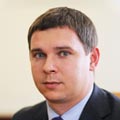Vladimir Evstifeev,
head of analytical department
Trading during the holidays traditionally takes place under conditions of low activity and increased volatility.
The ruble heads into the New Year holidays in good shape, having received support from the tax period and the global weakness of the US dollar. From the beginning of the first working week of 2024, a new format of the budget rule will begin to operate in favor of the Russian currency, and from January 12, the volume of currency purchases by the Central Bank of the Russian Federation will become clear, taking into account the estimates of the Ministry of Finance. Trading during the holidays traditionally takes place in conditions of low activity and increased volatility, so for non-speculative purposes you should wait until January 9.
Maxim Timoshenko,
Director of the Financial Markets Operations Department
From January 9, sales of foreign currency will resume within the framework of the fiscal rule
The end of the last working week in 2023 on the Moscow Exchange, the euro and dollar were met with an update of the November and December minimums. The ruble is supported by statements from the regulator that from January 9, sales of foreign currency will resume within the framework of the budget rule and operations will continue throughout the first half of the coming year. All other things being equal, increased ruble volatility is likely during the New Year holidays due to the illiquid market during the holidays. We predict the beginning of the new year for the dollar in the range of 89–91 rubles/$, for the euro – 98–100 rubles/€. At the same time, the ruble continues to be influenced by various factors, so the situation in January may change noticeably if one of them changes, for example, geopolitics, changes in energy prices, etc. A possible increase in budget expenditures may work against the ruble.
The start of the year is most often weak or neutral for the ruble
Our forecast for the ruble to dollar exchange rate for the first days of January is 88.5–91.5 rubles/$. News about the prospects for a multiple increase in foreign currency sales by the Central Bank in the first half of 2024 supported the national currency at the end of the week, but this was more of a psychological effect; in practice, the increase in foreign currency sales will manifest itself when they begin to increase in January. The start of the year is most often weak or neutral for the ruble – economic activity freezes in the first ten days of January, most investors are also not present in the market, there are usually few events and news. Therefore, with a high probability, if no geopolitical or external market shocks occur, we can expect the dollar exchange rate to remain relatively stable at the level of 90 rubles/$.
Dmitry Rozhkov,
treasury director
We do not expect increased volatility in the foreign exchange market
In the last two working days of the past year, the ruble began to strengthen and for the first time since November found itself below 89 rubles/$. The national currency was supported by the Bank of Russia’s announcement of the resumption of currency transactions from January 9. The daily volume of currency sales by the regulator in the first half of 2024 may amount to 11.8 billion rubles. without taking into account the adjustment of this amount for the volume of monthly oil and gas excess profits. Positive news for the ruble will continue to support the national currency next week. We do not expect increased volatility in the foreign exchange market and forecast a range in the ruble of 88.5–91.5 rubles/$.
Polina Khvoinitskaya,
Head of Investment Strategy and Analytics
The Russian currency will continue to trade below 90 rubles/$
For the New Year holidays, we predict trading at a rate in the range of 88–90.5 rubles/$. Traditionally, during the New Year holidays, the ruble exchange rate shows a high level of volatility due to the absence of the majority of trading participants. In the absence of negative events on the foreign policy circuit, the ruble will continue to gradually strengthen, tending to the lower limit of the range we indicated. Factors that strengthen the Russian currency are attractive yields on the Russian bond market and the effect of the decree on mandatory repatriation and sale of part of foreign currency earnings. Under the influence of these factors, the Russian currency will continue to trade below the level of 90 rubles/$ in the first quarter of 2024. In the medium term, a more optimal range that suits all market participants, in our opinion, will be 90–100 rubles/$. We predict this starting from the second quarter of 2024.
Stanislav Duzhinsky,
chief analyst
Fundamental factors will continue to operate
In January 2024, we can expect the ruble to resume growth. In addition to foreign currency sales by the Bank of Russia, this may be facilitated by the end of the period of increased demand for foreign currency and the traditional January decline in imports while export supplies continue. Fundamental factors that support the ruble will continue to operate—the obligations of exporters to sell foreign currency earnings and the high key rate of the Bank of Russia. In addition, positive macroeconomic data in the United States allows us to expect an easing of the Fed’s monetary policy in early spring, which leads to a depreciation of the dollar relative to other world currencies. We believe that in early January the rate will try to consolidate below 90 rubles/$ and in the future will move inside the target range of 85–90 rubles/$.








